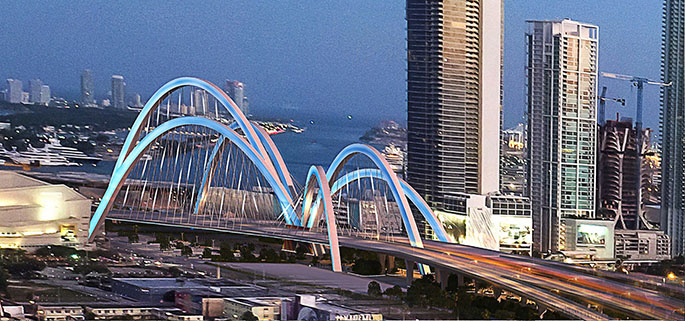Carlos Gimenez cronyism could cost us future millions
Miami-Dade Mayor Carlos Gimenez and his pals on the county commission are trying to sell us a bridge. Not just any bridge. His buddy’s bridge.
Recent hand-wringing over the selection of a firm to design and build an iconic, new signature bridge over Biscayne Boulevard along I-395 has cast a spotlight on just how 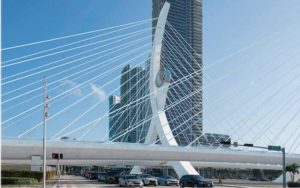 Gimenez uses the office of the the county mayor to benefit his friends and family members.
Gimenez uses the office of the the county mayor to benefit his friends and family members.
The beneficiary this time (again) is Pedro Munilla, who is cousins or something with the mayor’s wife and CEO of Munilla Construction Management. The company gets a lot of government contracts. But not this one (the rendition inset in this paragraph). MCM was one of five firms that bid on the $800 million “signature bridge” project, in partnership with Fluor Enterprises. But it was ranked second by a Florida Department of Transportation selection committee after a process that has taken, on and off, about 25 years. Archer Western/De Moya was ranked first.
Read related story: Miami-Dade mayor’s pal gets $6 mil extension on contract
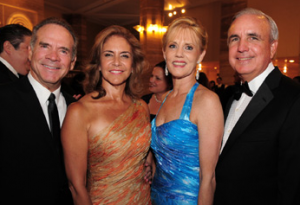
One week later, Gimenez wrote a letter asking the FDOT, which is providing $600,000 and overseeing the project, to delay the contract so that the county could weigh in (read: so that Munilla can get a second chance). And he’s using some of his pocket commissioners, like Sally Heyman — well, to be honest, the Munillas write a lot of checks — to try slow the process down. Heyman passed a resolution at the Transportation Planning Organization Thursday urging the FDOT to let them review the bids and provide feedback. It’s not like they don’t have the time anyway, she added, if the Munillas file a bid protest as they have said they intend to do (don’t they always?). That could take up to five or six months to resolve, according to FDOT Secretary James Wolfe, who looked like he couldn’t believe they were even talking about this.
Feedback on a selection that has already been made? To what end? Do these lunatics actually expect the FDOT to suddenly change their minds, switch gears and award the contract to the obviously politically-connected, second-ranked bidder that applied palanca?
That is the $800 million question. And, yes, they do. Because that’s how it’s done in the 305. The FDOT is a state agency used to dealing with state contracts where procurement is less, well, political. But it’s really not that complicated as everyone wants to make it seem. The argument that the mayor and Heyman are making center on the premise that there has not been enough community involvement. Suddenly, out of the blue, after the contract has been awarded, during a public process with dozens of meetings and during which a county commissioner served on an advisory committee, the mayor wrote that the county wants to have more input.
How much you wanna bet he wouldn’t be seeking that input if Munilla had gotten the contract?
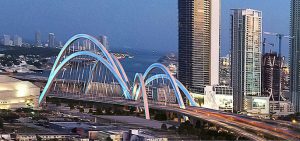
Because the truth is that, despite a Miami Herald story earlier this month that looks planted and almost manipulated by the mayor’s staff, there has been plenty of discourse and public input on the project. And Ladra is not just talking about the Aesthetic Review Committee on which Commissioner Audrey Edmonson sat, which was how the FDOT settled a lawsuit from city of Miami Mayor Tomas Regalado and then Commissioner Marc Sarnoff in 2013.
“What was settled in 2013 was not honored,” Heyman said at Thursday’s meeting.
Really, Sally? Really? Only Miami Gardens Mayor Oliver Gilbert got it right. The committee makes a recommendation. That doesn’t mean their recommendation has to override what the FDOT technical committee decides is the best bridge for traffic control reasons as well as aesthetic. Remember that easing traffic is the real reason they are doing this. Aesthetic concerns are just an additional bonus.
Read related story: Pot calls kettle black in Trial Rail bid protest by MCM’s Munilla
In fact, let’s review the history of the public input into efforts to build this particular bridge, which the FDOT started to look at around 1992. This timeline was put together with the help of three people close to the process, including a transportation professional and an engineer who has been working on different versions since the original 1992 one. Plus, Ladra was here the whole time.
Even back then, the back up from the northbound I-95 ramp on the 836 was causing havoc on downtown traffic, 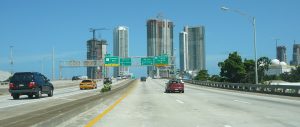 where ingress and outgress also wasn’t cake. There was also projected growth (its come true) that needed accomodating so they came up with a master plan that was not very masterful, just pretty much just widening and adding lanes. The black community balked because, shit, it looked like a repeat of what messed up Overtown so long ago when they first built I-95 and I-395 right through the community’s commercial streets. In 1996, the project died because there was so much community opposition.
where ingress and outgress also wasn’t cake. There was also projected growth (its come true) that needed accomodating so they came up with a master plan that was not very masterful, just pretty much just widening and adding lanes. The black community balked because, shit, it looked like a repeat of what messed up Overtown so long ago when they first built I-95 and I-395 right through the community’s commercial streets. In 1996, the project died because there was so much community opposition.
People still talked about doing something in the future, though. They had to. They knew something had to be done eventually. Ideas included tunnels and elevated options. Somewhere between 2003 and 2004, the TPO’s predecessor, the Metropolitan Planning Organization, asked the FDOT to look at it again and while they were doing that, Regalado and Sarnoff sued the state to ensure it would be an iconic bridge that would represent the city for decades to come. The settlement was the creation of an unprecedented aesthetics review committee that had, among its members, a representative from each the county, the city of Miami, the Downtown Development Authority and a 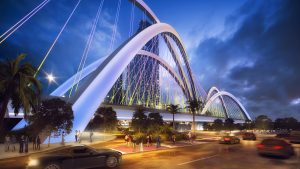 the Adrienne Arscht Center for the Performing Arts, which was next door.
the Adrienne Arscht Center for the Performing Arts, which was next door.
This commitee not only had a chance to take the original 18 bridges submitted and shortlist it to seven, they were also given a scoring role, which was not agreed to in the lawsuit settlement. They were given far more power than the FDOT needed to give them. But the state didn’t stop there.
The FDOT opened up an office in Overtown and met with hundreds of people over the course of years. Congresswoman Federica Wilson took a group of people because Ladra saw a picture of that meeting and of about a dozen other meetings where they discussed what they wanted to see in their neighborhood. Perhaps they couldn’t look at specific drawings. They couldn’t. The procurement process has to be done in a “cone of silence” precisely to keep the politics out of it. But they provided feedback on what they wanted to see. There was so much feedback, in fact, that transportation officials soon realized they would not be able to just widen and add lanes. They had to bring some life back into the neighborhood if the project was to move forward. The design includes a park underneath the bridge, the “Heritage Trail” that serves sort of like an North end Underline on steroids with actual historic significance in a part of the county and city that is too often ignored (more on that later).
The process has won awards for its public input. It has been an uprecedented process for FDOT.
And, now, because of the political meddling of a corrupt mayor, they will likely not repeat it. Who would blame them? This cronyism crap is probably also going to cost us millions in the future. Just when we are going to need state and federal dollars the most for our SMART plan to expand mass transit, our mayor pulls the political palanca stunt. Does he really think the FDOT is just going to forget about it and come back for more of this? Heck, there’s already talk that Tampa officials are calling the state agency and saying they will let the FDOT spend the $600 million in Tampa any way they want. And, believe me, those calls are getting more and more attention.
Read related story: Carlos Gimenez son’s firm got $4 million PAC repair job
Ladra is certain that the second-ranked Munilla bridge was pretty. It does look like dancers, however, and that may be why it got a perfect score from John Richard, director of the Adrienne Arscht Center for the Performing Arts (which three years ago gave a no-bid contract worth $4 million to a company that employed the mayor’s son). Richardstanked the other bidders and gave the Munilla project the only perfect score, which is the only reason that the Fluor/Munilla project got scored half a point under Archer Western. Expect Gimenez and others to make a big deal out of that small gap. But please remember that the only reason that happened was Richard’s scoring. He dnot only gave the only perfect scores to Fluor/Munilla, he was also the only one to score the Archer Western bridge as poor. Everybody else was either very good or good or excellent (which is what Edmonson ranked it). And remember that Richard’s facility depends on Gimenez for subsidies that are now competitively sought by other facilities, like the Frost and PAMM museums.
Maybe Richard is acting on Gimenez’s behalf. Because there is no doubt here that Gimenez is acting on his buddy Munilla’s behalf.
The fact that he is so bold and blatant about it is what should be most concerning. Because it shows that Gimenez, who is termed out after these next three and a half years, is going to use his remaining time on the 29th floor to get his friends and families as much as possible.
Like an $800 million bridge.

